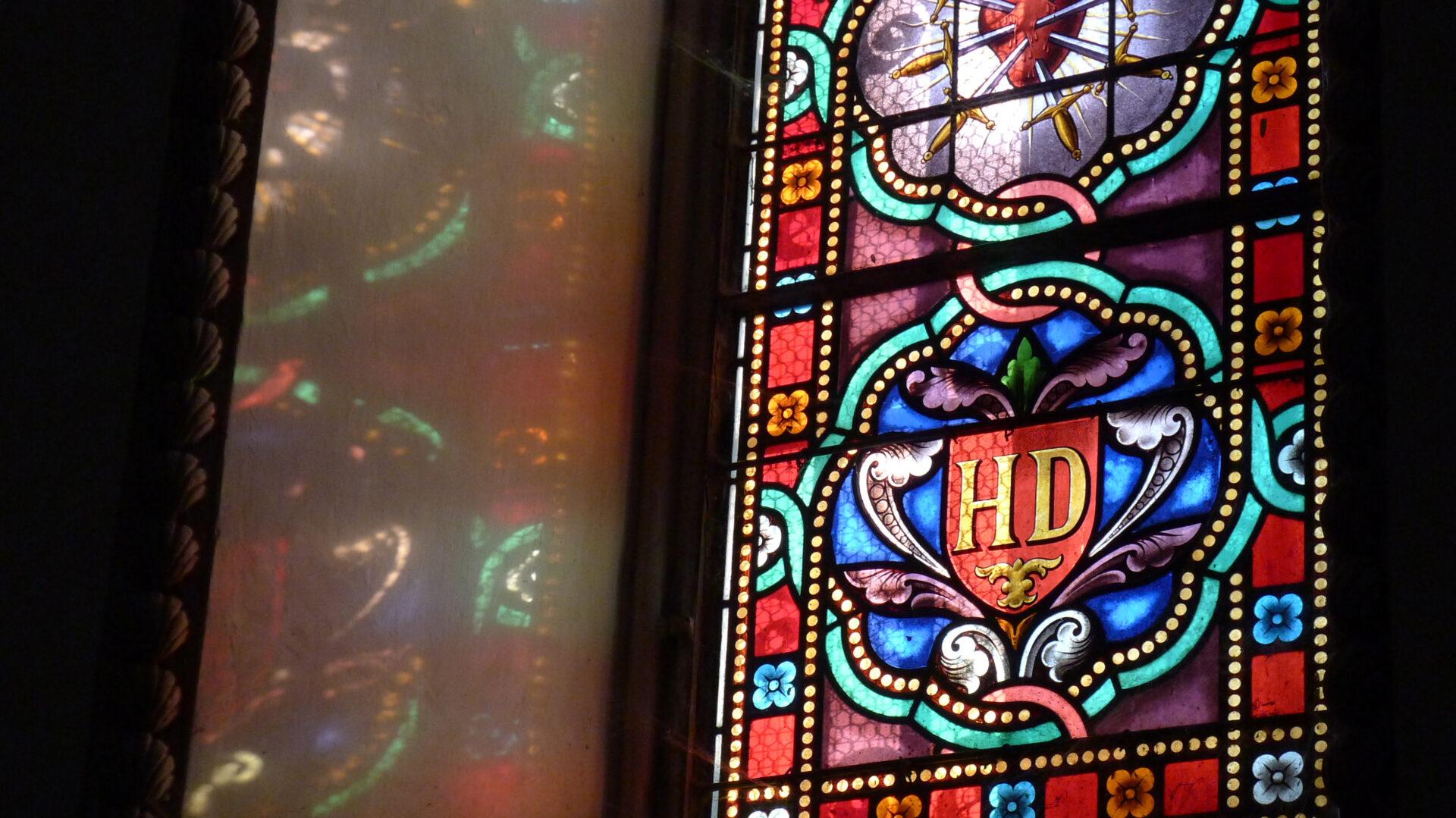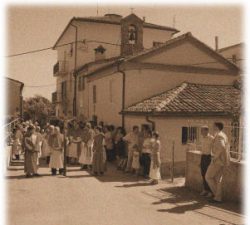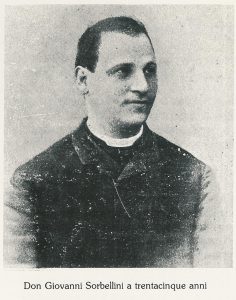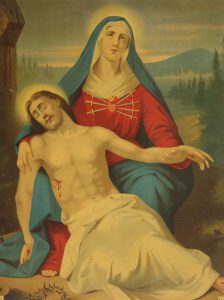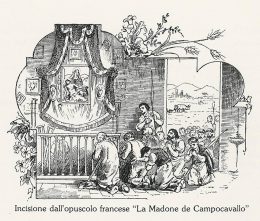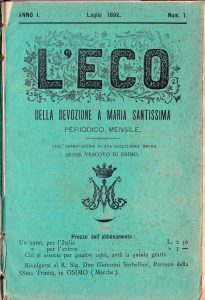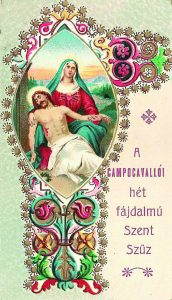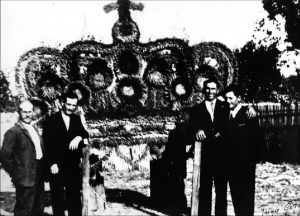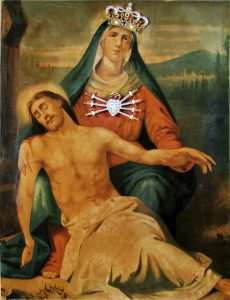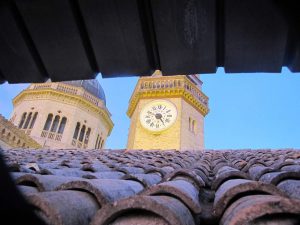Back in June 1892…
At the end of the nineteenth century, the village of Campocavallo, situated in the valley of the river Musone in the Italian Marche region, not far from the towns of Loreto and Osimo, was not much more than a simple crossroads with a few houses, a school and a small chapel.
The Chapel, built in around 1860 by a devout local inhabitant, offered to the local peasantry the possibility of attending Holy Mass without having to walk some kilometres to the nearest neighbouring church.
A young priest, the Reverend Giovanni Sorbellini, came on foot every Sunday from the town of Osimo to say Holy Mass in the chapel and attend to the spiritual needs of the faithful.
This is the historic setting in which Our Blessed Lady deigned to make Her presence felt as Our Lady of Sorrows.
Since the interior of little chapel was rather plain, Fr Giovanni procured two sacred images with which to adorn the walls.
An image of the Sacred Heart of Jesus and a Pietà, Our Lady of Sorrows holding in Her arms the body of Her lifeless Son with Her gaze turned toward the heavens.
16 June, Feast of Corpus Domini.
This is the date chosen by Our Lady for the first miracle. After Holy Mass a group of faithful was praying quietly when they suddenly realized that the image of Our Lady was covered with drops of water. At this sight a spontaneous cry arose from the crowd:”Our Lady is crying!“.
The tears of Our Lady were only the first part of the miracle, for with them She drew the attention of everyone to Her eyes, where a new miracle would shortly take place.
The following day many people arrived at the chapel to see the weeping image of Our Lady. While a large group of faithful gazed at the image, the eyes of Our Lady suddenly looked down!
The eyes of Our Lady of Sorrows were as if alive!
On the printed image, the pupils of Our Lady look upward toward heaven, but now they looked down toward the faithful!
The eyelids of Our Lady where seen to open and close as those of a living person, while Her face changed expression: She appeared to be looking at the people from the image!
The miracle continued to occur for at least a decade; in fact, even today, many pilgrims report having witnessed the movement of the eyes.
The extraordinary nature of the events that took place here lies not only in the prodigious event itself, but also and above all in the extraordinary events that happened afterwards.
Due to the great influx of pilgrims from Italy and abroad, many different languages were spoken in Campocavallo at that time.
As the months went by, news arrived constantly from all over the world of healings, graces and conversions obtained through the intercession of the Addolorata of Campocavallo.
Many of those who saw the miraculous movement left sworn testimonies attesting what they had seen.
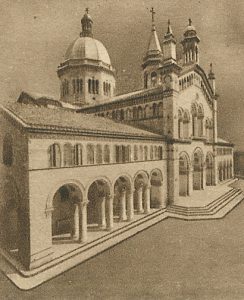
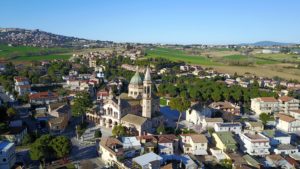
The other exceptional consequence was the construction of the new shrine, which was constructed entirely with to the money, materials and labour offered by the faithful. Over the years, the town of Campocavallo has grown around the imposing Sanctuary, which still houses the miraculous image.
Here you can download two of the most significant testimonies related to the miracle.
The ECO Magazine
In order to make the interventions of the Virgin Mary in Campocavallo more widely known, Fr. Giovanni Sorbellini decided to publish a magazine. Thus in the first year of the miracle he established the Eco della devozione all’Addolorata di Campovocavallo. During the construction of the Shrine, a small printing house was also born, dedicated to printing the magazine, pamphlets, prayers and sacred images of the miraculous Madonna.
On account of the large numbers of pilgrims from France, the Eco was also printed in French for about ten years. Pictures and prayers cards were printed in many European languages.
Don Giovanni diligently kept a record of everything that happened, including testimonies, donations, anecdotes and dates, and published much of this information in the Eco, which, for this reason, represents an extraordinary record of the whole story of Campocavallo.
THE “COVO” FESTIVAL
The miraculous image was adorned with jewels and precious stones: a crown, a diadem and a heart pierced by 7 swords.
On 30 March 1938 the image was stolen and found shortly after without its precious ornaments.
On the 13 August 1939 the Madonna was crowned again with new precious ornaments, and for the occasion the parishioners made an offering of thanksgiving to the Virgin, building a large crown of plaited wheat harvested from the local fields. This tradition was repeated each year, giving origin to the “Covo” festival, which has grown into an event of great cultural and religious importance.
Every first Sunday in August a wagon with a work made of braided ears of wheat, usually a scale reproduction of a sanctuary or a cathedral, parades through the town.
THE IMAGE
The miraculous image is an oleograph, a particular type of print that resembles an oil painting. It measures 38 x 52cm and portrays the Sorrowful Virgin holding the lifeless body of Jesus in her arms, after He was taken down from the cross.
Also depicted are some instruments of the passion, with the city of Jerusalem visible in the background. Our Lady has Her gaze raised to heaven, and displays, not resigned pain, but complete uniformity of Her will to the Divine Will.
TIMELINE
1870: Costruzione della Chiesetta del prodigio
1892: Il “Prodigio” della Madonna Addolorata (16-17 giugno)
1892: Posa della prima pietra del Santuario (10 dicembre)
1905: Dedicazione del Santuario (ultima domenica di settembre)
1915: Nascita della parrocchia di Campocavallo
1918: Morte di don Giovanni Sorbellini
1932: Incoronazione dell’Immagine della Madonna
1939: Origine della Festa del Covo
1955: Tumulazione privilegiata nel Santuario di don G. Sorbellini
2005-2007: Chiusura del santuario per imponenti lavori di ristrutturazione
2017: Progetto di valorizzazione “Lo sguardo che ci chiama”
PARROCI E RETTORI DEL SANTUARIO
1) Don Giovanni Sorbellini (1892-1918)
2) Don Arturo Cutoloni (1919-1926)
3) Don Ludovico Amadini (1926-1958)
4) Padre Pietro Giogoli (1948-1964)
5) Padre Luigi Ilari (1964-1984)
6) Padre Giuseppe Egidi (1984-1986)
7) Don Paolo Sconocchini (1987-2001)
8) Padre Giovanni Maria Severini (2001-2007)
9) Padre Giuseppe Grioni (2007-2014)
10) Padre Giovanni Maria Severini (2014-2016)
11) Padre Gabriele Insam (2016-2017)
12) Padre Giovanni Maria Severini (2017…
